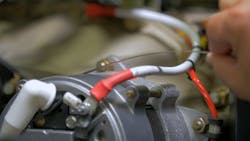The electrical system of a piston-engine airplane may seem simple enough, but therein lays the problem – it’s not. Aging wiring, connectors, batteries, and issues with other components can play havoc on not only the system’s performance, but also a technician’s ability to find and fix a problem.
As the director of product support for Hartzell Engine Technologies (HET), hardly a day goes by where we don’t get a call or email from a technician needing help weeding the gremlins out from under a customer’s cowling.
Many times, at least according to the technician’s diagnosis, the problem stems from a faulty alternator - especially if the pilot sees that little red light in the panel light up. But, in many cases, when we bench test these “failed” alternators we find that they’re actually working fine.
The problem is simply that not enough troubleshooting was done before pulling the alternator off the airplane. Keep in mind that just because the alternator went off line, it doesn’t mean the aircraft’s alternator itself has failed. The real issue could well be something else under the cowling.
There are a number of things, which may look like alternator problems that aren’t. Unfortunately, any of these issues will often lead to a “failure” indication. So if there’s a charging system issue, complete the following basic troubleshooting steps to the entire system before removing the aircraft’s alternator.
Even before they go out to the customer’s airplane, the first thing I tell technicians to do is to go to HET’s website and watch our short video on electrical system troubleshooting. You can find it at: https://www.youtube.com/watch?v=RocpYr5dmys
Alternator Troubleshooting Tips
As you will see in the video, an experienced mechanic can perform 95 percent of the steps to troubleshoot a piston-engine aircraft’s alternator using a flexible steel scale (not stainless) and a calibrated Volt/Ohm Meter (VOM).
(Tools photo: 0:57 HERE)
The first step is to switch on the aircraft’s Master and use the VOM to record the DC bus voltage for further troubleshooting reference.
(Bus photo: 1:54 HERE)
Next, with the aircraft’s Master and Alternator switches both on, place the metal scale on the alternator chassis. Energizing the aircraft’s alternator circuit while the unit is not running creates an electromagnet, so when you hold the scale against the housing you will get a light magnetic “tug”.
(TUG photo 2:17 here)
But, even if there is a tug you still need to verify that the aircraft’s alternator can carry a load. To do this, run the engine with the typical electrical load, connect a VOM to the B+ terminal and measure the voltage with respect to the ground. For 12- or 24-volt systems, if this is less than 13.5 or 25.5 volts respectively, when above 1,500 rpm, the alternator output is low.
If that does check out OK, switch the VOM to AC volts and verify a maximum of 1 volt AC into the bus. Failure of either of these tests would be cause to remove the alternator.
If there is no tug, then the alternator may well be working correctly and the problem could be a faulty voltage regulator, wiring, or an alternator field circuit, which leads to several other troubleshooting steps to help identify the issue:
1. While the engine is not running, verify field (F1) input voltage, which should be the approximate bus voltage. If not, check the regulator and associated connections, conductors, breakers, and switches.
(PHOTOS: 3:03 and 3:05 HERE)
2. Verify the l field resistance. With the F1 and F2 (if provided) field terminals isolated, measure for a resistance of approximately 4 to 8 ohms or 8 to 12 ohms depending on whether it’s a 12- or 24-volt system (respectively). If it’s not, remove the belt or alternator, if gear-driven, and slowly rotate the output shaft by hand. (PHOTOS: 4:06 and 4:09 HERE) If the resistance is high, not steady or infinite (using a calibrated VOM), you may have bad brushes, slip ring contamination, or an open rotor. If the resistance is “0”: The field circuit is shorted, which makes the rotor suspect.
3. Perform a “full fielding” test on the alternator. With the alternator field isolated from the regulator, connect a jumper from the B+ alternator output to the field terminal. This will provide full bus voltage directly to the field. Make sure no electrical equipment is “on.” Connect a VOM to the bus and run the engine. Since the only variable now is alternator rpm, the alternator DC voltage should smoothly follow the throttle as engine rpm is increased and decreased.
Common Voltage Regulator Problems
After testing and acceptance of the alternator, if the problem with the charging system still hasn’t been found, look at the voltage regulator next. Most aircraft voltage regulators used today are solid-state and no longer have the trouble-prone contact points and coils. As such, regulator maintenance, other than basic adjustments are minimal. Typically, today’s regulators either work or they don’t.
Unfortunately, as regulators have become more sophisticated and sensitive they are also more prone to providing false indications. These solid-state regulators along with glass cockpit warning systems are providing faster, but not necessarily better, information to the aircraft’s pilot and mechanic.
Voltage Regulator Troubleshooting Tips
Verify both the input and output voltage of the regulator. The input voltage should be approximately the same as the bus voltage. A drop of more than 0.5 volt would indicate an issue upstream of the regulator. If the drop between the input and the output of the regulator is beyond 1.5 volts, it’s a safe assumption that the regulator has a ground issue or internal fault.
Remember the solid-state design? Even a momentary, inadvertent alternator field short-to-ground can destroy the regulator.
Noise in the Headsets
Another common electrical system problem that can drive a technician to distraction is static or “noise” in the headsets. If your customer reports this problem, the best first step is to confirm AC output by setting the VOM to AC volts and measuring the bus voltage. The maximum should be 1 volt AC. A higher reading is a good indicator of a leaking diode.
Of course, these are just some very basic troubleshooting tips to aid aircraft maintenance technicians in eliminating the cost and aircraft downtime associated with the dreaded no-fault-found alternator. For a complete troubleshooting flow-chart, click here: http://hartzell.aero/wp-content/uploads/2015/10/Alternator-Trouble-Flowchart.pdf
Electrical systems are complex and can be affected by any number of problems. If you’ve followed these steps and still have not found the cause, give us a call at (+1-334-386-5400, option 2) or contact us via the web: (hartzell.aero/contact/) – the aircraft alternator experts at HET are here to help.



